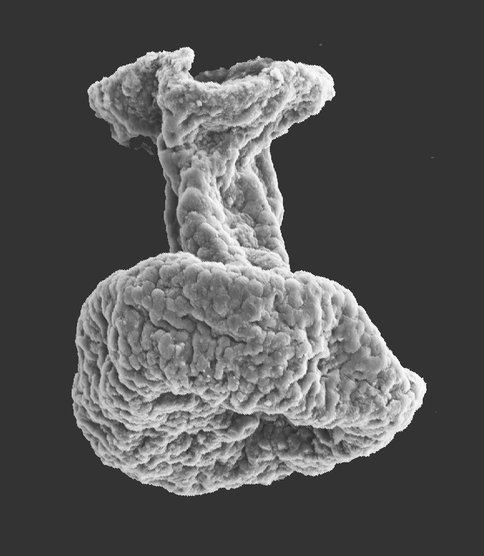2011 Annual Science Report
 Massachusetts Institute of Technology
Reporting | SEP 2010 – AUG 2011
Massachusetts Institute of Technology
Reporting | SEP 2010 – AUG 2011
Protists of the Neoproterozoic
Project Summary
T. Bosak (MIT), S. Pruss (Smith College), F. Macdonald (Harvard U.) and D. Lahr (U. Sao Paolo) discovered fossils of microscopic eukaryotes in limestone and dolostone strata deposited between the two Neoproterozoic low-latitude glaciations (between ~ 716 and 635 million years ago). These fossils include amoeba-like organisms that incorporated mineral-rich particles from the environment into their shells, mineral-rich shells of the oldest putative foraminiferans, and thick flask-shaped organic envelopes of the first putative ciliates, representatives of a major group of modern eukaryotes. These fossils demonstrate a previously unrecognized record of body fossils during the ~ 70 million years between the two “Snowball Earth” episodes and document the increasing diversity of morphologically and compositionally modern eukaryotes before the rise of complex animals.
Project Progress
T. Bosak (MIT), S. Pruss (Smith College), F. Macdonald (Harvard U.), D. Lahr (U. Sao Paolo) and E. Matys (MIT) recently discovered eukaryotic tests in stratigraphically unambiguous ~715-635 Ma strata. The fossil tests from the Rasthof Formation (Pruss et al., 2010) share compositional and morphological similarities with modern agglutinated lobose testate amoebae (Bosak et al., 2011), and agglutinated single-chambered foraminifera (Bosak et al., in press a). At present, this is the first known occurrence of widespread agglutination in the fossil record and the first occurrence of putative foraminiferans. Examination of less thermally altered strata deposited between ~715 and 635 Ma from Mongolia lead to the discovery of organic tests of the first putative ciliates (Bosak et al., in press b) and other remnants of fossil eukaryotes that are currently being investigated. The presence of phagotrophic eukaryotes capable of building recalcitrant organic and/or mineral-rich tests before 635 Ma attests to the increasingly complex trophic structure of the oceans during this time. This may have fundamentally changed the cycling of particulate and dissolved organic carbon in oceans, driving an increase in atmospheric oxygen and the subsequent radiation of metazoans.
Bosak, T., Lahr D.J.G., Pruss, S.B., Macdonald, F.A., Gooday, A.J., Dalton, L., and E.D. Matys, Possible early foraminiferans in post-Sturtian cap carbonates, Geology, in press.
Bosak, T., Lahr, D., Macdonald, F.A, and E.D. Matys, Putative Cryogenian ciliates from Mongolia, Geology, in press.
Bosak, T., Lahr, D., Pruss, S. B., Macdonald, F. A., Dalton, L., and E.D. Matys (2011) Agglutinated tests in post-Sturtian cap carbonates from Namibia and Mongolia, Earth and Planetary Science Letters, 308: 29-40.
Pruss, S.B., Bosak, T., Macdonald, F.A., McLane, M., and P.F. Hoffman (2010) Microbial facies in a Sturtian cap carbonate, the Rasthof Formation, Otavi Group, northern Namibia, Precambrian Research, 181: 187-198.
Figure 1. Microfossil of a putative ciliate extracted from 716-635 Ma limestone strata from Mongolia (transmitted light). The fossil consists of a flexible, ~ 100 micrometer long flask-shaped organic envelope with a constricted neck, a flaring collar and a bowl-shaped end. This fossil is remarkably similar to modern tintinnids, herbivorous planktonic ciliates.
Figure 2. Microfossil of a putative ciliate extracted from 716-635 Ma limestone strata from Mongolia (scanning electron micrograph). The flexible, ~ 100 micrometer long flask-shaped organic envelope has a constricted neck, a flaring collar and a bowl-shaped end and contains numerous adjacent alveolate structures that may have facilitated flotation. This fossil is remarkably similar to modern tintinnids, herbivorous planktonic ciliates.
Publications
-
Bosak, T., Lahr, D. J. G., Pruss, S. B., MacDonald, F. A., Dalton, L., & Matys, E. (2011). Agglutinated tests in post-Sturtian cap carbonates of Namibia and Mongolia. Earth and Planetary Science Letters, 308(1-2), 29–40. doi:10.1016/j.epsl.2011.05.030
-
Bosak, T., Lahr, D. J. G., Pruss, S. B., MacDonald, F. A., Gooday, A. J., Dalton, L., & Matys, E. D. (2011). Possible early foraminiferans in post-Sturtian (716-635 Ma) cap carbonates. Geology, 40(1), 67–70. doi:10.1130/g32535.1
-
Bosak, T., MacDonald, F., Lahr, D., & Matys, E. (2011). Putative Cryogenian ciliates from Mongolia. Geology, 39(12), 1123–1126. doi:10.1130/g32384.1
-
Pruss, S. B., Bosak, T., MacDonald, F. A., McLane, M., & Hoffman, P. F. (2010). Microbial facies in a Sturtian cap carbonate, the Rasthof Formation, Otavi Group, northern Namibia. Precambrian Research, 181(1-4), 187–198. doi:10.1016/j.precamres.2010.06.006
-
PROJECT INVESTIGATORS:
-
PROJECT MEMBERS:
Tanja Bosak
Project Investigator
Francis Macdonald
Co-Investigator
Sara Pruss
Co-Investigator
Daniel Lahr
Collaborator
Emily Matys
Research Staff
-
RELATED OBJECTIVES:
Objective 4.1
Earth's early biosphere.
Objective 4.2
Production of complex life.
Objective 5.2
Co-evolution of microbial communities
Objective 6.1
Effects of environmental changes on microbial ecosystems

